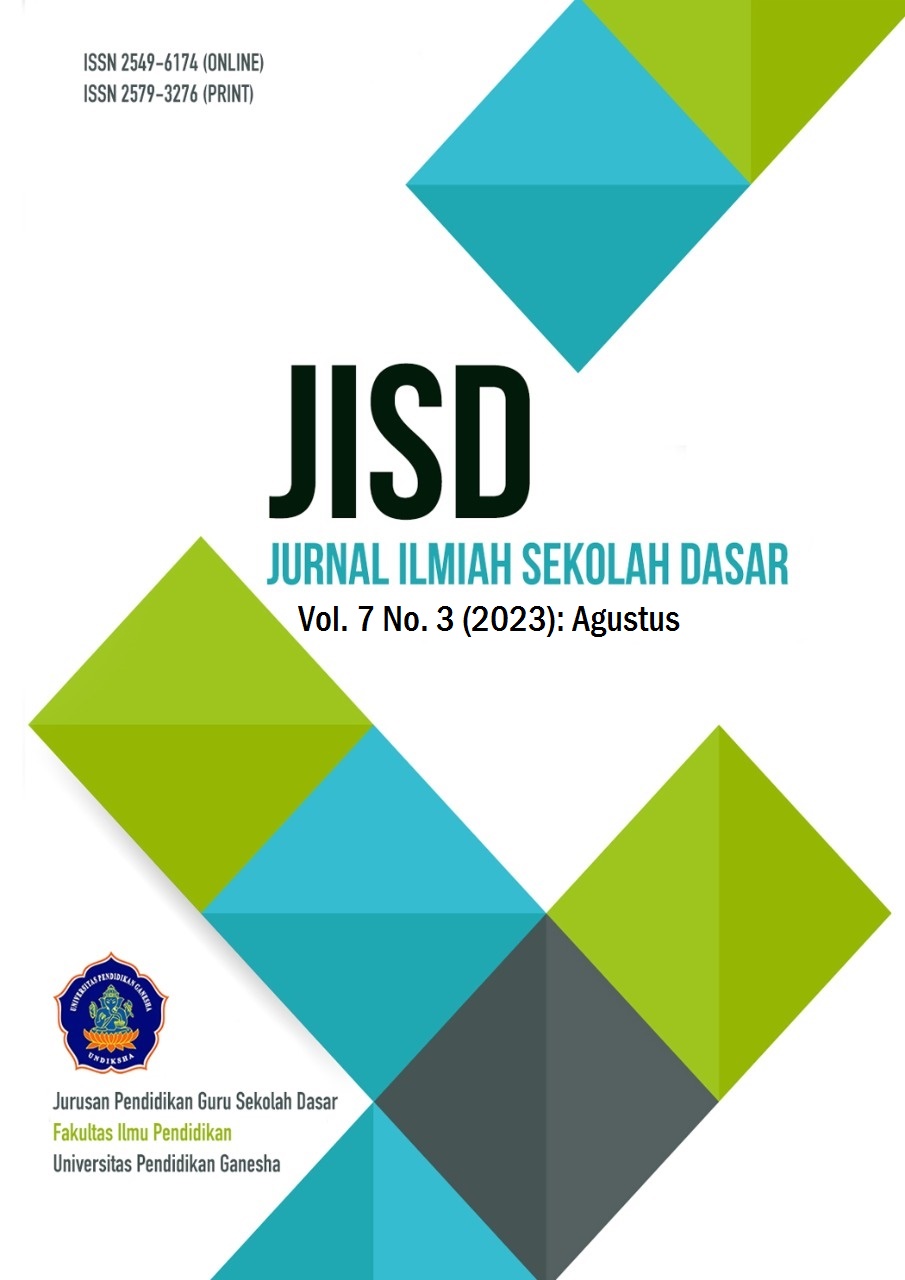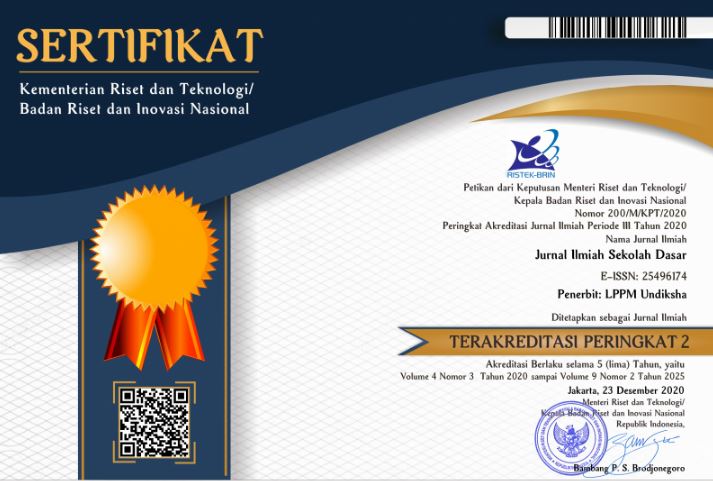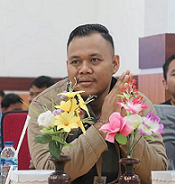Tri Hita Karana-Based Thematic Teaching Materials on the Topic of Clean, Healthy, and Beautiful Environment
DOI:
https://doi.org/10.23887/jisd.v7i3.51709Keywords:
Teaching materials, Tri Hita Karana, ThematicAbstract
The lack of thematic teaching materials provided by schools and the government encourages teachers to focus on learning that does not refer to local wisdom, and the materials used are not contextual. Responding to this phenomenon, this study aims to develop Tri Hita Karana-based thematic teaching materials for grade 1 elementary school students. This type of research is developed using the ADDIE model. The methods used to collect data are observation and questionnaires. The instrument used to collect data is a questionnaire. The research subjects were learning material experts and learning media experts. The test subjects were students totaling 10 people. The technique used to analyze the data is descriptive qualitative and quantitative analysis. The results of the study, namely the results of the validity test, were declared valid with a Content Validity Coefficient of 1. Thematic teaching materials also met the practicality criteria with a score of 4.9 in the very practical category. Based on the trial, it was found that the teaching materials were very effective, with an average student score of 88 with 90% completeness. It was concluded that teaching materials in the form of Tri Hita Karana-based Thematic Teaching Materials for a clean, healthy, and beautiful environment are appropriate and effective for use in learning.
References
Arista, F. S., & Kuswanto, H. (2018). Virtual physics laboratory application based on the android smartphone to improve learning independence and conceptual understanding. International Journal of Instruction, 11(1), 1–16. https://doi.org/10.12973/iji.2018.1111a. DOI: https://doi.org/10.12973/iji.2018.1111a
Artati, Y., Tumirah, & Suparmo. (2016). Hubungan Antara Pemanfaatan Internet Sebagai Sumber Belajar Dengan Prestasi Belajar Mahasiswa Semester III Prodi Diii Kebidanan Sutomo Surabaya. SAINTEKBU, 3(1). https://doi.org/10.32764/saintekbu.v3i1.43. DOI: https://doi.org/10.32764/saintekbu.v3i1.43
Astuti, E. P., & Supriyono, S. (2020). Karakteristik Pelaksanaan Pembelajaran Matematika Berbasis Etnomatematika Untuk Siswa Sekolah Menengah Pertama. Jurnal Pendidikan Surya Edukasi (JPSE), 6(1), 49–60. https://doi.org/10.37729/jpse.v6i1.6492. DOI: https://doi.org/10.37729/jpse.v6i1.6492
Budiwibowo, S. (2016). Membangun Pendidikan Karakter Generasi Muda Melalui Budaya Kearifan Lokal Di Era Global. Premiere Educandum : Jurnal Pendidikan Dasar dan Pembelajaran, 3(01), 39–49. https://doi.org/10.25273/pe.v3i01.57. DOI: https://doi.org/10.25273/pe.v3i01.57
Coyne, E., Rands, H., Frommolt, V., Kain, V., Plugge, M., & Mitchell, M. (2018). Investigation of blended learning video resources to teach health students clinical skills: An integrative review. In Nurse Education Today (Vol 63, bll 101–107). Elsevier. https://doi.org/10.1016/j.nedt.2018.01.021. DOI: https://doi.org/10.1016/j.nedt.2018.01.021
Daryanti, D., Desyandri, D., & Fitria, Y. (2019). Peran Media dalam Pembelajaran Seni Budaya dan Keterampilan Di Sekolah Dasar. EDUKATIF : JURNAL ILMU PENDIDIKAN. https://doi.org/10.31004/edukatif.v1i3.46. DOI: https://doi.org/10.31004/edukatif.v1i3.46
Ferri, F., Grifoni, P., & Guzzo, T. (2020). Online Learning and Emergency Remote Teaching: Opportunities and Challenges in Emergency Situations. Societies, 10(4), 86. https://doi.org/10.3390/soc10040086. DOI: https://doi.org/10.3390/soc10040086
Firdaus, F. M., & Badriyah, N. (2018). Penerapan Pembelajaran Tematik Berbasis Budaya Betawi untuk Meningkatkan Logical Intelligence Siswa SD Islam Taman Qur’aniyah Jakarta Selatan. Al Ibtida: Jurnal Pendidikan Guru MI, 5(1), 95. https://doi.org/10.24235/al.ibtida.snj.v5i1.2727. DOI: https://doi.org/10.24235/al.ibtida.snj.v5i1.2727
Fugard, A. J. B., & Potts, H. W. W. (2015). Supporting thinking on sample sizes for thematic analyses : a quantitative tool. International Journal of Social Research Methodology, 18(6), 667–681. https://doi.org/10.1080/13645579.2015.1005453. DOI: https://doi.org/10.1080/13645579.2015.1005453
Grønlien, H. K., Christoffersen, T. E., Ringstad, Ø., Andreassen, M., & Lugo, R. G. (2021). A blended learning teaching strategy strengthens the nursing students’ performance and self-reported learning outcome achievement in an anatomy, physiology and biochemistry course – A quasi-experimental study. Nurse Education in Practice, 52(June 2020). https://doi.org/10.1016/j.nepr.2021.103046. DOI: https://doi.org/10.1016/j.nepr.2021.103046
Hamid, M. A., Aribowo, D., & Desmira, D. (2017). Development of learning modules of basic electronics-based problem solving in Vocational Secondary School. Jurnal Pendidikan Vokasi, 7(2), 149. https://doi.org/10.21831/jpv.v7i2.12986. DOI: https://doi.org/10.21831/jpv.v7i2.12986
Hanifah, H. (2015). Penerapan Pembelajaran Model Eliciting Activities (MEA) dengan Pendekatan Saintifik untuk Meningkatkan Kemampuan Representasi Matematis Siswa. Kreano Jurnal Matematika Kreatif-Inovatif, 6(2), 191–198. https://doi.org/10.15294/kreano.v6i2.4694. DOI: https://doi.org/10.15294/kreano.v6i2.4694
Hartini, S., Misbah, Dewantara, D., Oktovian, R. A., & Aisyah, N. (2017). Developing learning media using online prezi into materials about optical equipments. Jurnal Pendidikan IPA Indonesia, 6(2), 313–317. https://doi.org/10.15294/jpii.v6i2.10102. DOI: https://doi.org/10.15294/jpii.v6i2.10102
Hidayah, D. N., & Priscylio, G. (2019). Pengembangan Bahan Ajar Mandiri Pokok Bahasan Suhu dan Kalor Menggunakan Software Camtasia. Journal of Teaching and Learning Physics, 4(1), 50–64. https://doi.org/10.15575/jotalp.v4i1.4093. DOI: https://doi.org/10.15575/jotalp.v4i1.4093
Hulukati, W., & Rahmi, M. (2020). Instrumen Evaluasi Karakter Mahasiswa Program Pendidikan Guru Pendidikan Anak Usia Dini. Jurnal Obsesi : Jurnal Pendidikan Anak Usia Dini, 4(2). https://doi.org/10.31004/obsesi.v4i2.468. DOI: https://doi.org/10.31004/obsesi.v4i2.468
Joshi, O., Chapagain, B., Kharel, G., Poudyal, N. C., Murray, B. D., & Mehmood, S. R. (2020). Benefits and Challenges of Online Instruction in Agriculture and Natural Resource Education. Interactive Learning Environments, 1–12. https://doi.org/10.1080/10494820.2020.1725896. DOI: https://doi.org/10.1080/10494820.2020.1725896
Kandakatla, R., Berger, E. J., Rhoads, J. F., & DeBoer, J. (2020). Student perspectives on the learning resources in an Active, Blended and Collaborative (ABC) pedagogical environment. International Journal of Engineering Pedagogy, 10(2), 7–31. https://doi.org/10.3991/ijep.v10i2.11606. DOI: https://doi.org/10.3991/ijep.v10i2.11606
Karisma, I. K. E., Margunayasa, I. G., & Prasasti, P. A. T. (2020). Pengembangan Media Pop-Up Book pada Topik Perkembangbiakan Tumbuhan dan Hewan Kelas VI Sekolah Dasar. Jurnal Ilmiah Sekolah Dasar, 4(2), 121. https://doi.org/10.23887/jisd.v4i2.24458. DOI: https://doi.org/10.23887/jisd.v4i2.24458
La’ia, H. T., & Harefa, D. (2021). Hubungan Kemampuan Pemecahan Masalah Matematis dengan Kemampuan Komunikasi Matematik Siswa. Aksara: Jurnal Ilmu Pendidikan Nonformal, 7(2), 463–474. https://doi.org/10.37905/aksara.7.2.463-474.2021. DOI: https://doi.org/10.37905/aksara.7.2.463-474.2021
Lubis, R., Herlina, M., & Rukmana, J. (2019). Pengaruh Model Pembelajaran Think Pair Share Menggunakan Media Mind Mapping terhadap Aktivitas dan Hasil Belajar Kognitif Siswa. BIOEDUSAINS: Jurnal Pendidikan Biologi dan Sains, 2(2). https://doi.org/10.31539/bioedusains.v2i2.978. DOI: https://doi.org/10.31539/bioedusains.v2i2.978
Molenda, M. (2003). In search of the elusive ADDIE model. Performance Improvement, 42(5), 34–36. https://doi.org/10.1002/pfi.4930420508. DOI: https://doi.org/10.1002/pfi.4930420508
Mufida, L., Yunitasari, E., & Ulfiana, E. (2021). Health Education of Clean and Healthy Lifestyle using Card Telling Methods towards Diarrhea Prevention Among Children in Elementary School. Pediomaternal Nursing Journal, 7(1). https://doi.org/10.20473/pmnj.v7i1.21184. DOI: https://doi.org/10.20473/pmnj.v7i1.21184
Mustofa, R., & Syafi’ah, R. (2018). Pengembangan Media Pembelajaran Pop Up Book Materi Kenampakan Permukaan Bumi Mata Pelajaran IPA Kelas III SD. ELSE (Elementary School Education Journal), 2, 30–41. https://doi.org/10.30651/else.v2i2.1723. DOI: https://doi.org/10.30651/else.v2i2.1723
Nur Jannah, I. (2020). Efektivitas Penggunaan Multimedia dalam Pembelajaran IPA di SD. Jurnal Ilmiah Sekolah Dasar, 4(1), 54. https://doi.org/10.23887/jisd.v4i1.24135. DOI: https://doi.org/10.23887/jisd.v4i1.24135
Pradnyawathi, N. N., Chintya, & Agustika, S. (2019). Pengaruh Model Pakem Berbasis Tri Hita Karana terhadap Keterampilan Menulis. International Journal of Elementy Education, 3(1), 89–98. https://doi.org/10.23887/ijee.v3i1.17660. DOI: https://doi.org/10.23887/ijee.v3i1.17660
Pratama, I. G. D. J., Dantes, N., & Yudiana, K. (2020). Thematic Learning Plan With A Nature Of Science Learning Model In The Fourth Grade Of Elementary School. International Journal of Elementary Education, 4(4), 447–453. https://doi.org/10.23887/ijee.v4i4.27208.
Purnomo, H., & Wilujeng, I. (2016). Pengembangan Bahan Ajar dan Instrumen Penilaian IPA Tema Indahnya Negeriku Penyempurnaan Buku Guru dan Siswa Kurikulum 2013. Jurnal Prima Edukasia, 4(1), 67–68. https://doi.org/10.21831/jpe.v4i1.7697. DOI: https://doi.org/10.21831/jpe.v4i1.7697
Putra, G., & Agustiana, I. (2021). E-LKPD Materi Pecahan dalam Pembelajaran Daring. MIMBAR PGSD Undiksha, 9(2), 220–228. https://doi.org/10.23887/jjpgsd.v9i2.35813. DOI: https://doi.org/10.23887/jjpgsd.v9i2.35813
Rochman, C., Nasrudin, D., Muslim, & Hermita, N. (2017). Characteristics of the ability of physics concept in enrichment teaching materials of natural and mineral resources (NMRs) literacy. Jurnal Pendidikan IPA Indonesia, 6(2), 252–256. https://doi.org/10.15294/jpii.v6i2.9482. DOI: https://doi.org/10.15294/jpii.v6i2.9482
Rohimatusa’diyah, Pamungkas, A. S., & Alamsyah, T. P. (2020). Penggunaan ( LKS ) Eksploratif Berkonteks Budaya Banten Terhadap Kemampuan Pemecahan Masalah Matematis Siswa di SD. Jurnal Ilmiah Sekolah Dasar Universitas Pendidikan Ganesha, 4(2), 290–298. https://doi.org/10.23887/jisd.v4i2.24274. DOI: https://doi.org/10.23887/jisd.v4i2.24274
Samri, F., Rewo, J. M., & Laksana, D. N. . (2020). Electronic Thematic Teaching Multimedia with Local Culture Based Materials and Its Effect on Conceptual Mastery of Primary School Students. European Journal of Education Studies, 7(2), 625–641. https://doi.org/10.46827/ejes.v7i12.3474.
Sarbini, Rahtikawati, Syamsudin, & Zaqiah. (2021). A Religious based Education Concept for Good Personality Development in a Crisis: The Case of Improving Indonesian Students Morals and Character. Review of International Geographical Education (RIGEO), 11(5). https://doi.org/10.48047/rigeo.11.05.165.
Saripudin, E., Sari, I. J., & Mukhtar, M. (2018). Using Macro Flash Animation Media on Motion Material to Improve Learning Achievement for Learning Science in Junior High School. Jurnal Penelitian dan Pembelajaran IPA, 4(1), 68–75. https://doi.org/10.30870/jppi.v4i1.3316. DOI: https://doi.org/10.30870/jppi.v4i1.3316
Saryantono, B., & Nurdiana, A. (2018). Pelatihan pendekatan saintifik dalam pembelajaran matematika bagi guru SMA Adiguna Bandar Lampung. Adiguna: Jurnal Pengabdian dan Pemberdayaan Masyarakat, 3(1), 25–30. https://doi.org/10.1093/oseo/instance.00191269. DOI: https://doi.org/10.1093/oseo/instance.00191269
Simanihuruk, L. A., & Simanungkalit, N. M. (2019). Pengaruh Penggunaan Internet Sebagai Sumber Belajar Pada Materi Penginderaan Jauh dan Sig Terhadap Hasil Belajar Tengah Semester Geografi Kelas XII IPS SMA Negeri 21 Medan. Tunas Geografi, 7(1). https://doi.org/10.24114/tgeo.v7i1.11087. DOI: https://doi.org/10.24114/tgeo.v7i1.11087
Sirnayatin, T. A. (2017). Membangun Karakter Bangsa Melalui Pembelajaran Sejarah. SAP (Susunan Artikel Pendidikan), 1(3), 312–321. https://doi.org/10.30998/sap.v1i3.1171. DOI: https://doi.org/10.30998/sap.v1i3.1171
Sriyanto, Leksono, & Harwanto. (2019). Bahan Ajar PPKn Berbasis Karakter dan Literasi Untuk Siswa Kelas IX SMP Al Hikmah Surabaya. Edmotech, 4(2), 130–142. https://doi.org/10.17977/um039v4i22019p130. DOI: https://doi.org/10.17977/um039v4i22019p130
Sukardi, Mayefis, R., & Usmeldi. (2020). Effectiveness of Mobile Learning Media on Computer Assembly at Vocational High School Effectiveness of Mobile Learning Media on Computer Assembly at Vocational High School. Journal of Physics: Conference Series, 1–6. https://doi.org/10.1088/1742-6596/1594/1/012012. DOI: https://doi.org/10.1088/1742-6596/1594/1/012012
Susilowati, S. (2017). Pengembangan Bahan Ajar IPA Terintegrasi Nilai Islam untuk Meningkatkan Sikap dan Prestasi Belajar IPA Siswa. Jurnal Inovasi Pendidikan IPA, 3(1), 78–88. https://doi.org/10.21831/jipi.v3i1.13677. DOI: https://doi.org/10.21831/jipi.v3i1.13677
Syafrijal, & Desyandri. (2019). Deveopment Of Integrated Thematic Teaching Materials With Project Based Learning Models In Class IV of Primary School. International Journal of Educational Dynamics/IJEDS, 1(2), 87–92. https://doi.org/10.24036/ijeds.v1i2.110.
Taqiyyah, S. A., Subali, B., & Handayani, L. (2017). Implementasi Bahan Ajar Sains Berbahasa Inggris Berbasis Metakognitif Untuk Meningkatkan Kemampuan Pemecahan Masalah Siswa SMP. Jurnal Inovasi Pendidikan IPA, 3(2), 224–234. https://doi.org/10.21831/jipi.v3i2.14859. DOI: https://doi.org/10.21831/jipi.v3i2.14859
Trianggono, M. M. (2017). Analisis Kausalitas Pemahaman Konsep Dengan Kemampuan Berpikir Kreatif Siswa Pada Pemecahan Masalah Fisika. Jurnal Pendidikan Fisika dan Keilmuan (JPFK), 3(1), 1. https://doi.org/10.25273/jpfk.v3i1.874. DOI: https://doi.org/10.25273/jpfk.v3i1.874
Ula, I. R., & Fadila, A. (2018). Pengembangan E-Modul Berbasis Learning Content Development System Pokok Bahasan Pola Bilangan SMP. Desimal: Jurnal Matematika, 1(2), 201. https://doi.org/10.24042/djm.v1i2.2563. DOI: https://doi.org/10.24042/djm.v1i2.2563
Warkintin, W., & Mulyadi, Y. B. (2019). Pengembangan Bahan Ajar Berbasis CD Interaktif Power Point Untuk Meningkatkan Hasil Belajar Siswa. Scholaria: Jurnal Pendidikan dan Kebudayaan, 9(1), 82–92. https://doi.org/10.24246/j.js.2019.v9.i1.p82-92. DOI: https://doi.org/10.24246/j.js.2019.v9.i1.p82-92
Yoga, I. P., & Astra, I. M. (2020). Pendidikan Karakter di Lingkungan Keluarga Selama Pembelajaran Jarak Jauh pada Masa Pandemi COVID-19. Cetta: Jurnal Ilmu Pendidikan, 3(2), 270–290. https://doi.org/10.37329/cetta.v3i2.454 DOI: https://doi.org/10.37329/cetta.v3i2.454
Yunita, N. K. D., & Tristiantari, N. K. D. (2019). Pengaruh Model Pembelajaran Kooperatif Tipe Tgt Berbasis Kearifan Lokal Tri Hita Karana Terhadap Hasil Belajar. Jurnal Pendidikan Multikultural Indonesia, 1(2), 96. https://doi.org/10.23887/jpmu.v1i2.20778. DOI: https://doi.org/10.23887/jpmu.v1i2.20778
Yusnia, Y. (2019). Penggunaan Media Video Scribe Dalam Pembelajaran Literasi Sains Untuk Mahasiswa PGPAUD. Cakrawala Dini: Jurnal Pendidikan Anak Usia Dini, 10(1), 71–75. https://doi.org/10.17509/cd.v10i1.17436. DOI: https://doi.org/10.17509/cd.v10i1.17436
Downloads
Published
How to Cite
Issue
Section
License
Copyright (c) 2023 Gede Dharmawan Gede Dharmawan

This work is licensed under a Creative Commons Attribution-ShareAlike 4.0 International License.
Authors who publish with the Journal Ilmiah Sekolah Dasar agree to the following terms:
- Authors retain copyright and grant the journal the right of first publication with the work simultaneously licensed under a Creative Commons Attribution License (CC BY-SA 4.0) that allows others to share the work with an acknowledgment of the work's authorship and initial publication in this journal.
- Authors are able to enter into separate, additional contractual arrangements for the non-exclusive distribution of the journal's published version of the work (e.g., post it to an institutional repository or publish it in a book), with an acknowledgment of its initial publication in this journal.
- Authors are permitted and encouraged to post their work online (e.g., in institutional repositories or on their website) prior to and during the submission process, as it can lead to productive exchanges, as well as earlier and greater citation of published work. (See The Effect of Open Access)










